| Author |
Message |
|
Alex Indman
|
 Posted: Fri 20 Dec, 2013 8:37 pm Post subject: Landsknecht Dagger of Saxon type - DIY project Posted: Fri 20 Dec, 2013 8:37 pm Post subject: Landsknecht Dagger of Saxon type - DIY project |
 |
|
Hi guys,
decided to post my current project as "work in progress". Almost done with the dagger itself, and will post about the bodkin separately. Need to assemble the dagger, make the by-knife, and of course scabbard (which will probably be as much work as dagger itself).
I got interested lately in so called Landsknecht daggers of their several types, especially the "Saxon" type. First reading some books, and then that dagger of this type that sits in a display case full of Saxon rapiers in the Metropolitan Museum really caught my eye... I spent quite a bit of time at that display bending and squirming around to take a look from odd angles, and took notes for my project. The famous "Catalog of European Daggers" by Bashford Dean helped a lot, too.
Choice of blade was hard. A proper blade for this type of dagger would have to be custom ordered and I didn't want to put that kind of money into an experimental hobby project. In the end, I got a cheap big dagger blade from Atlanta Cutlery ( http://www.atlantacutlery.com/p-923-arkansas-...de-12.aspx ).
It is decent carbon steel, not too hard but tough enough (sort of springy) and takes a good edge. Funny thing is that the tang is MUCH better than the round rat-tail they show. It is actually as wide and solid as one could want. I had to file and bend it a lot to make it straight and centered, though.
I changed the blade profile a little at the base to make it look more "interesting" (have seen some parrying daggers in books with similar profile). Also sharpened the blade (it came unsharpened) and refinished it to 600 grit satin finish.
See the picture of modified blade (along with all prepared parts for the handle) and compare with the original at the above link.
 Attachment: 137.51 KB Attachment: 137.51 KB
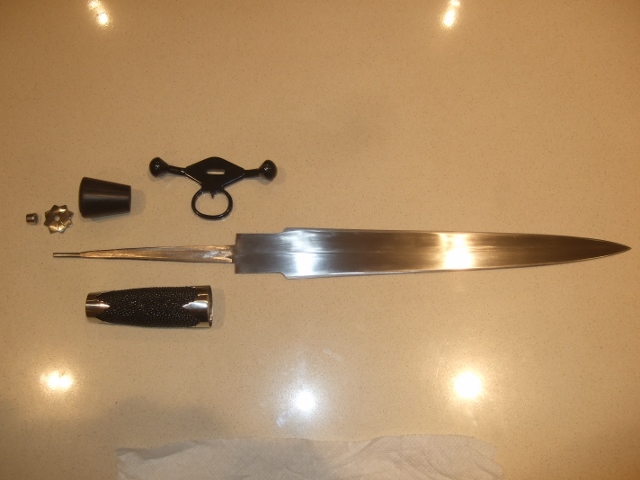
|
|
  |
 |
|
Alex Indman
|
 Posted: Fri 20 Dec, 2013 8:53 pm Post subject: Posted: Fri 20 Dec, 2013 8:53 pm Post subject: |
 |
|
More on the handle parts, see better picture of them.
Handle is poplar wood covered in ray skin (I used part with small "nodules" so it looks close to sharkskin on the original in Metropolitan). Painted black, again as original.
Crown shaped collars are mirror polished nickel silver for nice contrast with the black handle. Same for the decorative top plate and button.
Guard is blued mild steel (1018). Used "cold blue" solution on it, produced a pretty nice deep black color. This is my first try at a steel guard, until now I used only soft metals in my projects (copper/brass/nickel silver). The shape is a little simpler than the original, but I am rather proud of how it came out anyway. Not bad for a first try, isn't it?
Pommel is one part I still have some misgivings about... I used ebony wood for it instead of steel, so there is some color mismatch (it is very dark brown, but not quite black as guard and handle). But I figured I wouldn't be able to produce it of steel: solid would require too much stock removal (and too heavy for a dagger), bending and soldering in this shape too complicated for my skills.
More to follow when the dagger is assembled...
 Attachment: 155.08 KB Attachment: 155.08 KB
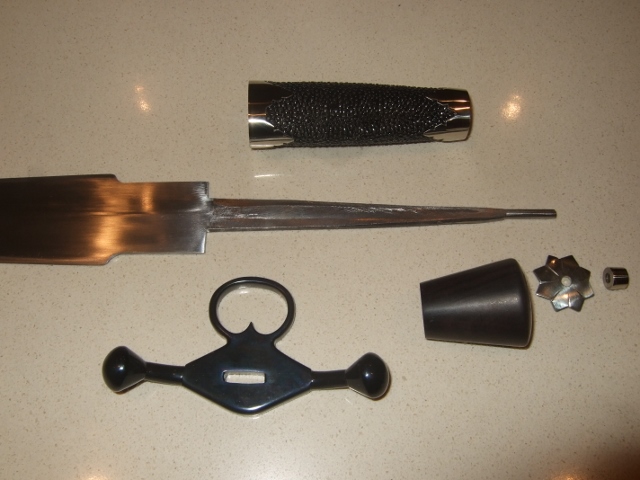
|
|
  |
 |
Dean F. Marino

Location: Midland MI USA Joined: 24 Aug 2011
Posts: 229
|
 Posted: Sat 21 Dec, 2013 2:30 pm Post subject: Posted: Sat 21 Dec, 2013 2:30 pm Post subject: |
 |
|
Lovely job - and major points for innovation, starting with a good commercial blade  . Just curious... was this blade the (poorly named) Arkansas Toothpick? I've got a WIP based on a similar blade - still need to wrap & make a scabbard.... . Just curious... was this blade the (poorly named) Arkansas Toothpick? I've got a WIP based on a similar blade - still need to wrap & make a scabbard....

In edhil, hai edhil. In edain, hai edain.
|
|
  |
 |
|
Alex Indman
|
 Posted: Sun 22 Dec, 2013 6:54 pm Post subject: Posted: Sun 22 Dec, 2013 6:54 pm Post subject: |
 |
|
Yes, this was the Arkansas Toothpick blade from Atlanta Cutlery (I bought it from the link in my post above).
Now, as promised, pictures of the assembled dagger.
With this big, wide, and relatively flat blade it feels to me more like an all-around sidearm conceptually similar to Japanese Wakizashi (not just dedicated parrying implement for rapier play). Would be an effective cut and thrust weapon in tight quarters or when there was no time to draw the rapier. Pure fantasy, of course...
 Attachment: 135.51 KB Attachment: 135.51 KB
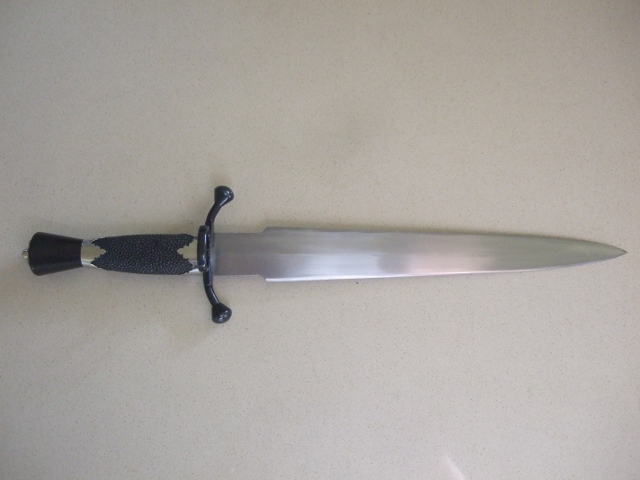
 Attachment: 113.96 KB Attachment: 113.96 KB
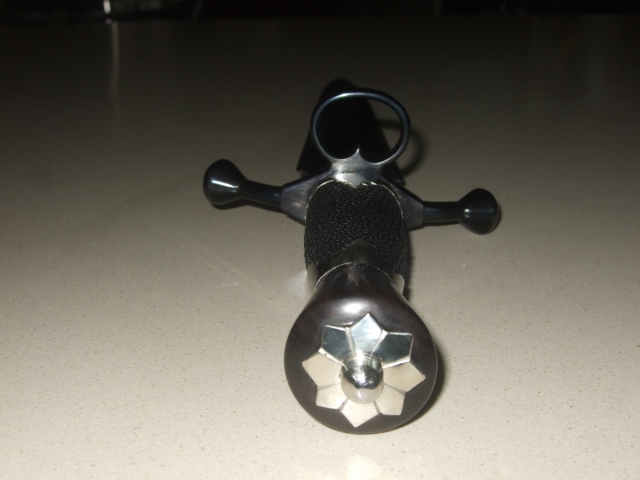
|
|
  |
 |
Nathan Robinson
myArmoury Admin


|
 Posted: Sun 22 Dec, 2013 6:57 pm Post subject: Posted: Sun 22 Dec, 2013 6:57 pm Post subject: |
 |
|
I always thought it was unusual to include the Saxon types of daggers into a Landsknecht definition. A couple sources do this, but they date to a period of arms and armour history that really seemed to value the over-categorization of items, even when unrelated, or only very loosely associated. A strange classification, regardless.
.:. Visit my Collection Gallery :: View my Reading List :: View my Wish List :: See Pages I Like :: Find me on Facebook .:.
|
|
    |
 |
|
Alex Indman
|
 Posted: Mon 23 Dec, 2013 8:30 am Post subject: Posted: Mon 23 Dec, 2013 8:30 am Post subject: |
 |
|
Nathan, I agree that this is a strange classification. For some reason, 3 very different types of daggers are lumped under "Landsknecht" group. The only thing I can see in common between them is heavily (or fully) metal mounted scabbards. And maybe the blade type - they all tend to be rather thick and narrow and not too long (under about 10").
As the handle/guard goes they have nothing in common:
- "Saxon" type is more like generic parrying daggers, just with shorter quillons and wider pommel. I think this is the best all-around dagger style of the period, good looking and practical for carry in different positions and use in any fighting style.
- "Katzbalger" type has S-shaped guard and handle just like smaller version of Katzbalger swords.
- the last type is the one I would call "Landsknecht" specifically if I were coming up with my own classification. Thin plate guard shaped like relatively short wide "petals" of varying form bent toward the blade. Handle a pronounced cone - very thin at the blade, very wide at the pommel. This type looks pretty, but I can't imagine it being comfortable in use. I would say it is impractical for anything but stabbing in an "icepick" grip. Surprising that it was popular at the time when grappling in full armor was pretty much out and parrying with left hand daggers was in...
|
|
  |
 |
|
Alex Indman
|
 Posted: Mon 06 Jan, 2014 5:09 am Post subject: Posted: Mon 06 Jan, 2014 5:09 am Post subject: |
 |
|
An update - matching by-knife and bodkin are done. Next step will be the scabbard for the whole set.
 Attachment: 128.61 KB Attachment: 128.61 KB
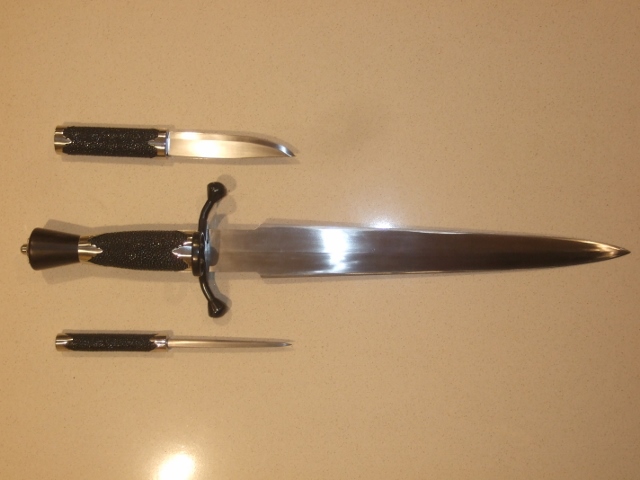
|
|
  |
 |
|
Alex Indman
|
 Posted: Wed 10 Sep, 2014 6:09 am Post subject: Project finished! Posted: Wed 10 Sep, 2014 6:09 am Post subject: Project finished! |
 |
|
Finally, the scabbard is done and I am finished with this project! Took something like 2 years on and off since I started research for it.
Scabbard mounts are nickel silver, soldered from sheet stock. The only part I bought ready made is the "finial" at the end (actually sold as a pommel). I decided against fabricating something like it because it would require buying a very expensive thick rod of NS.
Construction and decorative elements are mostly very close to the historical examples I found (the simpler ones, without heavy ornamentation).
Here is how it all looks together (see attached pictures):
 Attachment: 345.69 KB Attachment: 345.69 KB
[ Download ]
 Attachment: 157.26 KB Attachment: 157.26 KB
[ Download ]
|
|
  |
 |
|
Alex Indman
|
 Posted: Wed 10 Sep, 2014 6:32 am Post subject: Posted: Wed 10 Sep, 2014 6:32 am Post subject: |
 |
|
And a couple more pictures to show the two belt loops on the back of the scabbard (exactly like on the originals, for example the one in the Metropolitan museum), and how the dagger looks when worn horizontally at the back, handle to the right.
According to what I found in my research, this was the most common period way to wear daggers of this type.
Very comfortable to wear and to draw with right hand (in either "icepick" or "blade forward" grip).
However, I found that trying to draw with left hand is extremely hard, almost impossible. This goes against what Tarassuk says in his "Notes on Parrying Daggers and Poniards" (a great article, BTW). And I am not particularly fat or short armed...
Has anybody here experimented with this kind of dagger wear/draw? Just curious if it's just me, or something is wrong with Tarassuk's theory that one would normally draw a parrying dagger from this position while already holding a rapier in his right hand.
Alex.
 Attachment: 177.48 KB Attachment: 177.48 KB
[ Download ]
 Attachment: 264.52 KB Attachment: 264.52 KB
[ Download ]
|
|
  |
 |
|
T. Kew
Location: London, UK Joined: 21 Apr 2012
Posts: 256
|
 Posted: Wed 10 Sep, 2014 10:48 am Post subject: Posted: Wed 10 Sep, 2014 10:48 am Post subject: |
 |
|
I would tend to consider a dagger worn in that way as a weapon to draw first, with speed, and then transfer to the left hand if you want to draw a sword with the right. This also means you always have a hand available for instant use, which is quite nice.
So were you attacked in a bar, you can first instantly draw your knife to parry or fight in close quarters, and if you have the distance and time, pass it to the left and draw your rapier as well (say as the fight moves out into the street, if you were the protagonist in a swashbuckling novel).
I have a passing recollection of a 16th century author advocating infantry have their daggers set up to be drawn with the right hand for speed, but I'm afraid I have nothing to turn that into an actual source.
|
|
  |
 |
|
Alex Indman
|
 Posted: Wed 10 Sep, 2014 1:37 pm Post subject: Posted: Wed 10 Sep, 2014 1:37 pm Post subject: |
 |
|
This was exactly the hypothetical scenario I was thinking about. Great minds think alike and all that. 
All the evidence I could find (like the famous portrait of Drake) show handle to the right, approximately at the right elbow.
Only one author (a late XIXc Russian) stated "worn at the back with handle to the left" for all similar types of daggers (Landsknechts, Swiss) but I think this was simply an error. Specifically for Swiss (Holbein) daggers, if worn in this way the figures in scabbard decoration would appear heads down!
So there is little doubt these daggers were commonly worn the way I set mine up.
I was just surprised by Tarassuk's theory that one would draw the rapier first, then the dagger with left hand. He wrote that this was easy to do, and even possible "while wearing half armor". But then he was a professional fencer, so maybe more agile than most of us...
Alex.
|
|
  |
 |
|
|

